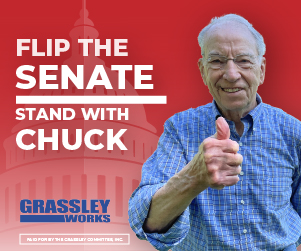As we enter year three of fighting the coronavirus pandemic, we must acknowledge our healthcare system’s strengths while working to fix our weaknesses. We have seen some incredible medical innovations come out of these past few years, from vaccines to booster shots to widespread testing. However, our hospitals are still packed due to the new omicron variant, millions of Americans are without health insurance, and medical care is still too expensive for so many Iowans.
I’m disappointed to say that even when so many are struggling, hospitals are actively exploiting federal policies meant to help vulnerable patients. The most egregious example of this exploitation is the 340B Drug Pricing Program, a federal program established with the noble goal of making healthcare affordable for uninsured and low-income patients seeking care at community health centers and nonprofit hospitals.
Unfortunately, 340B never explicitly defined how savings from the program were to be used and left the eligibility criteria broad and unregulated. This lack of regulation has allowed huge hospital corporations that give away very little charity care to take advantage of the program The program was originally intended to provide discounts to a small group of 90 charity care hospitals, but now covers more than 2,500 hospitals posing as “nonprofit charity hospitals”.
A recent national study of 340B hospitals by the Pacific Research Institute (PRI) found that not only do “non-profit” 340B hospitals make 37% more in profits compared to the average of all hospitals, but these 340B hospitals that are supposed to providing charity care give 22% less of their net patient revenue to charity care than all hospitals. PRI’s study also took a detailed look at two of Iowa’s 340B entities, St. Luke’s Methodist Hospital in Cedar Rapids and Genesis Health in Davenport (Genesis Health’s hospital, Genesis Medical Center, was used for its charity care numbers). Both entities generated hundreds of millions in net patient revenue for FY 2018 or FY 2017 but gave away tiny fractions of this revenue (0.19 percent and 0.68 percent respectively) to charity care.
Both uninsured and insured patients are paying the cost of these 340B hospitals making more money and giving away less in charity care. According to CAO-cited data from the Office of Inspector General, more than 60 percent of hospitals did not offer the reduced 340B prices to uninsured patients and these hospitals charge uninsured patients up to three times more than what hospitals pay for the drugs. To make matters worse, even insured patients pay more for prescriptions. A 2014 Journal of American Medical Association study reported that drug manufacturers are forced to increase drug prices to offset the discounts given to the now-massive 340B program. The 340B program is now almost as large as the Medicaid program’s outpatient drug sales but lacks the regulatory safeguards to protect it from exploitation.
Our federal government certainly had the right intentions when creating the 340B program which was meant to provide much-needed drug discounts to hospitals providing charity care to low-income and uninsured patients. However, it’s clear we need to close the loopholes in the program to stop greedy hospital corporations from manipulating the system and profiting off the patients they are supposed to be helping.
Dan Smicker – DeWitt, Iowa



